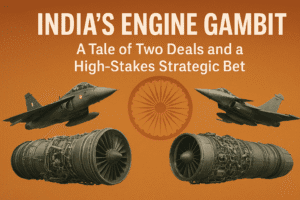India’s Engine Gambit: A Tale of Two Deals and a High-Stakes Strategic Bet
India is pursuing a high-stakes, dual-track strategy to secure fighter jet engines, reflecting its complex diplomatic ties. A deal with the US’s GE Aerospace provides immediate capability through licensed production of F-414 engines, but it comes with restricted technology transfer and keeps India dependent on American control for future upgrades. In contrast, a truer co-development partnership with France’s Safran promises full technology transfer and shared intellectual property, aiming to build sovereign, long-term engine capability.
This approach underscores a trust-based relationship with France versus a more transactional one with the US. However, operating two different engines for its future AMCA fighter jets introduces significant operational challenges, including massive redesign costs, duplicated logistics, and strained budgets. Ultimately, this gamble balances urgent military needs against the strategic goal of self-reliance.

India’s Engine Gambit: A Tale of Two Deals and a High-Stakes Strategic Bet
India’s quest for self-reliance in fighter jet engines, a pinnacle of aerospace technology, has taken a dramatic and unprecedented turn. Instead of a single path, the nation is embarking on a high-risk, high-reward strategy involving two of the world’s major powers: the United States and France. This twin-track approach is more than a procurement decision; it’s a live-action case study of India’s evolving diplomatic calculus and its starkly different experiences with global partners.
At its heart, the gamble is this: can India simultaneously secure its immediate military needs while building a sovereign capability for the future? The answer depends on the success of two very different deals.
The American Deal: A Transaction of Necessity
The agreement between Hindustan Aeronautics Limited (HAL) and America’s GE Aerospace to licence-produce the F-414 engine is a deal born of urgency. It’s designed to power the critical Tejas Mk-2 light combat aircraft and serve as a “bridging” engine for the first two squadrons of India’s ambitious fifth-gen AMCA fighter.
On the surface, the offer is attractive, promising up to 80% technology transfer. However, a closer look reveals the carefully drawn boundaries typical of US defence exports. The “crown jewels” of jet engine technology—the proprietary process for casting single-crystal turbine blades, the core software (FADEC) that acts as the engine’s brain, and the secret metallurgical recipes for the super-hot sections—are expected to remain firmly under American control.
This isn’t necessarily malice; it’s the ingrained “export-control culture” of Washington. The deal provides India with the ability to manufacture, but not the freedom to innovate on the platform. The intellectual property stays with GE, meaning India cannot independently modify, export, or develop derivatives without explicit US approval. This arrangement secures immediate capability but keeps India on a strategic leash, dependent on its partner for future upgrades and support.
The French Partnership: An Investment in Sovereignty
In stark contrast, the recently unveiled government-to-government deal with France’s Safran is structured as a true co-development program. The goal is to create a brand new, more powerful 110-125 kN engine from the ground up for the future AMCA Mk-2.
This partnership promises what India has craved for decades: 100% technology transfer and shared intellectual property rights. It is not a sale, but an invitation into the design room. This framework would grant India the sovereign right to adapt, upgrade, and maintain the engine entirely on its own terms, even for potential export, without needing to seek permission from Paris.
This level of trust is not new. It’s built on a long history of reliable French partnership, from the Toofani jets of the 1950s to the Mirage 2000s and modern Rafales. Crucially, France stood by India after the 1998 nuclear tests when most of the Western world, led by the US, imposed sanctions. This history informs the present trust, making the Safran deal less of a transaction and more of a shared strategic investment.
The Operational Tightrope
While diplomatically astute, running two parallel engine programs introduces formidable operational challenges for the Indian Air Force (IAF). As veteran pilots caution, “fighters are built around their powerplants.”
Fielding the AMCA with two different engines—the GE F-414 for the Mk-1 and the new Safran-DRDO engine for the Mk-2—is akin to developing two separate aircraft. It necessitates a complete redesign of the fuselage, intakes, and flight controls for the Mk-2, leading to extended test cycles and colossal redesign costs.
On the ground, the IAF will face a logistics nightmare: two completely different sets of training programs for pilots and mechanics, two separate maintenance pipelines, and two inventories of specialized spare parts. This duplication will inevitably inflate life-cycle costs and strain an already tight defence budget, potentially slowing the induction of these critical assets precisely when the IAF’s squadron strength is at a historic low.
The twin-engine strategy is a revealing mirror of India’s global relationships.
The US deal offers a proven, off-the-shelf solution to an immediate problem but comes with inherent technological constraints and is currently mired in trade-related delays. It is a pragmatic, transactional partnership where technology is carefully metered out.
The French deal offers a long-term vision of strategic autonomy, built on a foundation of historical trust and a willingness to share core technological sovereignty. It is a riskier, longer road, but one that promises a far greater reward: true self-reliance.
India’s gamble is that the short-term certainty of the American deal will buy it the time needed to realize the long-term promise of the French one. The success of this bold bet will determine not only the future of India’s air power but also its position as a truly independent player on the world’s strategic stage.
You must be logged in to post a comment.